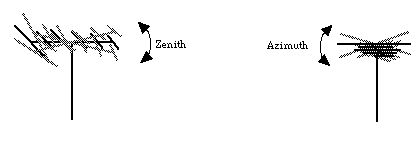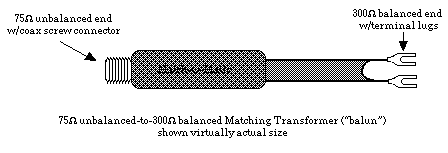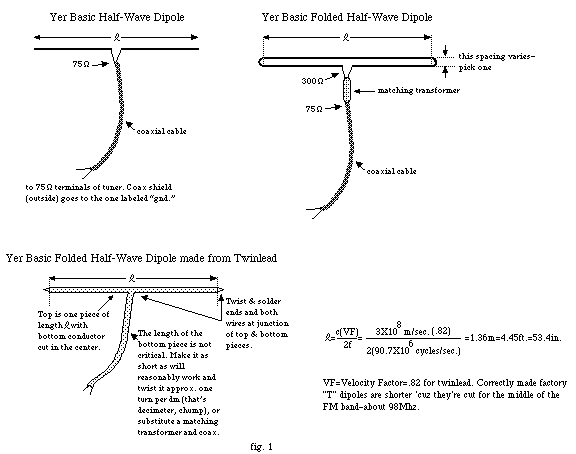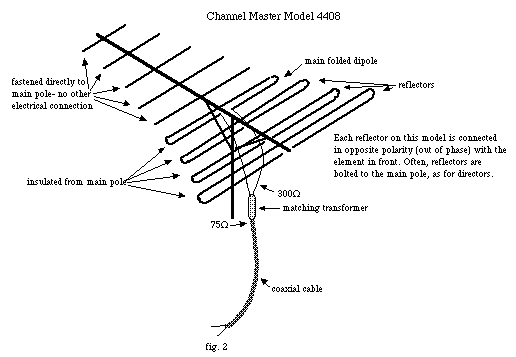The Blowin’ in the Wind Up on the Roof Sonically Pure method for Well-To-Do Homeowners and Flat-Broke Experimenters
Gotta roof? Use it! If you own your dwelling unit (or have way cool landspeople as i do {props to Tom & Barbara!}), you have no excuse! There’s probably an existing TV antenna cold chillin’ up there doing nothing.
My Aim is True
Step one: turn it so it faces the transmitter site of your fave station (yes, you will have to figure out where it is) if it isn’t aimed that way already.
Step two: tighten it in its new position, find/fix/replace the lead-in wire, and hightail it to yer receiver/tuner. You may be amaaaazed what even a rusty rooftop TV antenna can do.
Speaking of aiming, remember: FM is great, but it’s weird. Sometimes you’ll get better sound pointed not quite at yer target, occasionally even 60-70° off. Since you’re already a nonconformist, don’t be shy about tilting the antenna front up or down (zenith adjust), or even adjusting azimuthally, if this helps.

If possible, run a veryveryveryvery long headphone cable up to the rooftop antenna, and listen whilst you twist, or see about installing a rotator (bringing the receiver to the roof negates the lead-in wiring, and may produce deceptive results. Wireless headphones will add their own reception problems to the mix, confounding everything).
If you’re presently using a rooftop configuration you inherited from someone else, you’re disappointed with its performance, and you haven’t personally inspected roofland nor participated beyond sticking the wire into the tuner, beware the following: FM traps, corrosion, broken connections, aimed incorrectly, wrong cable. Despite previous comments, clean, intact rooftop antennas outperform rusty/corroded/broken ones. Though you could get busy w/the steel wool, it’s probably best to start with a new unit, complete with state-o’-art oxidation reduction protection. Similarly, unless the cabling is high-grade coaxial, start afresh. You may also need transformers to match 75 ohm coaxial cable to a (typically) 300 ohm antenna, and possibly the receiver (consult yer owner’s manual or local audio guru if in doubt). Aim per the preceding paragraph, and watch out for those pesky FM traps! See, some wacky humans actually want to watch television, and sometimes a powerful FM radio broadcast station will interfere, and ruin their pickypix. Those clever TV antenna guys’ll install a filter (FM Trap) at the antenna, in the antenna (especially Winegards), or at the TV set. Some impedance matching transformers include an FM Trap (they usually will proudly declare such is the case on their housing). Since the trap’s job description is to dump as much 88-108 MHz as possible, needless to say you won’t get optimum FM reception with one of these in the line. Make it go away.
For Well-to-do Homeowners and Lucky Renters
If there isn’t anything usable up there, or if you want the absolute best sound you can possibly get, buy a brand-new FM-only rooftop antenna, and new “lead-in” wire. Although nearly anything on the roof will beat anything in the house, get the biggest, longest “deep fringe” antenna you can afford, even if you live down the street from your station (well OK…if you’re closer than 3 blocks, use a “T”. Over the last 25 years, the best brands have been Channel Master and Winegard. Here i must reiterate my utter amazement at how little respect FM radio garners, and how difficult it has become to find what no FM radio home should be without: a top-notch rooftop antenna with rotator. In the process of obtaining current prices in June 1995 for a setup identical to what i’ve been using since 1986, i found prices half again more than ’86, and the rotator company of choice out of business. Interestingly, with the push for HDTV in the mid-oughts (i.e. as of 2005), rooftop antennae and rotators are making a (likely short-lived) comeback, and y’all once again have the choice of having near-CD quality “underground” radio for a few more years ’til digital radio drops, your fave station finally goes digital, and you drop a few Benjies on your newflimsyfangled offshore digital receiver with the incomprehensible owner’s manual, destined to break within two years…. And unlike internet streaming circa 2005, no dropouts! Don’t accept crap—insist on known quality.
I bought a top-of-the line Channel Master model 4408 in 1986 for under $60. In the mid-’90’s it’s become the 3025, with a suggested list of (all prices US)$90.09, though Pacific Valley in Dublin, CA @ (510) 829-5960 (voice) has ’em for $80.12. It’s big, sorta phallic & ugly, but i get the locals with no noise all the time in my rented natural habitat here in Albany, and get Napa, Cupertino (89 km/55 miles away) and beyond quite listenably.
Heavy Rotation
Any antenna of this type is highly directional (to block out other unwanted stations on the same frequency, and multipath “bounce” signals of the station you want), and requires a rotation mechanism (unless you never listen to anything besides your one chosen station!).
If you’re really a fabrication wizard, perhaps you’ll make your own rotation scheme. Most of us will buy an electric antenna rotator. Simple concept: motor on pole turns antenna, box in house controls motor. Not so simple to do well—many cheap rotators stop dead in their tracks in just a few years. And what happens when the wind changes direction?
Look for motors housed in metal, preferably bare galvanized aluminum. The Lance LC100A (formerly Alliance) continues to serve well, despite many gnarly storms ($56 in 1986). Unfortunately, you can’t buy one new today, as the company bailed on the rotator market around the turn of the decade (you could always bug them in email ![]() ). You could try the Channel Master 9521a TV Antenna Rotator With Remote (somewhere around US$72 to US$100 as of Feb. 2005). While not as durable as the old Alliance/Lance models, my parents have been using a similar, older Channel Master rotator since mid-1996, which is still working just fine. Radio Shack has a decent, yet not outstanding, antenna rotator in 2005, for US$75.
). You could try the Channel Master 9521a TV Antenna Rotator With Remote (somewhere around US$72 to US$100 as of Feb. 2005). While not as durable as the old Alliance/Lance models, my parents have been using a similar, older Channel Master rotator since mid-1996, which is still working just fine. Radio Shack has a decent, yet not outstanding, antenna rotator in 2005, for US$75.
If ya wanna go high-end, head to your local ham shack (Ham Radio Outlet, explain what you are doing, and walk out with one of their light-duty models (what is extra-heavy-duty in the TV antenna world becomes light-duty in the ham radio world). Disclaimer: the author has never used antenna rotators intended for amateur radio, nor seen them up close, really. They are probably overkill, so you might want to revisit what is available for Tee Vee, esp. during the current HDTV push.
Since the typical noncommercial music radio listener is good with her/his hands, and doesn’t enjoy spending this kind of money (except, perhaps, at the local recorded music purveyor…), Sonic suggests revisiting the homebrew approach, or (better) scouring garage sales, Salvation Army, Goodwill, salvage places like Urban Ore, etc. for used antenna rotators. Buy early and buy often.
Keep in mind that the rotator system consists of the motor box up on the roof, special cable (usually 4 wires), and a control box in the house. While the cable can be almost anything 18ga. or bigger with the correct number of conductors and hookup, the box must match the motor, unless you’re a real hotshot (in which case you wouldn’t be reading this). So get the motor and box together, or pay no more than $1, and keep looking for the missing piece(s). Electronics studs may be successful making their own control box (go all the way: link it to your digital tuner presets to automatically rotate to the current station, after a time delay {the motors aren’t rated for continuous duty}).
Lead Me To Your Lead-In

A top-notch antenna needs top-notch cabling. Don’t even think about using anything unshielded (e.g. “twinlead”). I chose what the cable installers use(d): Belden 9114 Duobond II CATV Coax (just ask for Belden 9114). This is a premium low-loss 75 ohm coaxial shielded cable specially designed to carry TV/FM signals without mucking them up, and you can actually still buy it these days ($51.75/500' from Newark Electronics in September 1999, and it’s still state of the art. 500' [about 150m] is the smallest box [eep!], so you may need to go in with a friend, or find a philanthropic CATV installer).
Many antennas (such as the 4408/3025) are 300 ohm, so you’ll need a matching transformer

(sometimes called a “balun”), to convert the 300 ohm antenna signal to a 75 ohm signal that the cable knows how to carry. If your tuner/receiver has 75 ohm connections, connect the coax cable directly there, otherwise you’ll need a second matching transformer for the receiver end. Some folks claim RMS brand matching transformers lose less signal—i don’t know—they work for me.
You will also need assorted poles, mounting brackets, nuts, bolts, and other goodies specific to your installation, especially if there’s no old TV antenna to evict. To figure out your particular hardware requirements, consult a do-it-yourownbadself book, do a web search and hope something useful has shown up in the years since i wrote this article, or find sympathetic (and hopefully cheap) expertise (my rate is $1 a minute). Antennae, rotators, and relevant hardware are still barely available at well-stocked TV shops and electronics stores. You will probably not be able to get everything under one roof unless you opt for inferior brands/models. Phone around, and beware of saleslime pushing the brand they happen to sell….
When time matters more than money…
If you’re really well-to-do or don’t enjoy hanging out on the roof, pay through the nose for someone to do all this for you—it’s worth it if you love radio. By the by, if you’re one of those aforementioned wacky vidkid humans, all the above will getcha great off-air video too, if you substitute a mondo-big VHF/UHF/FM antenna (i use a Channel Master Quantum 1160A, and get Monterey & Sacramento on T.V.—with snow), and throw in a signal splitter (NO FM TRAPS!!-watch out!-many splitters have them).
For Flat-Broke Experimenters
If you twitched at every price listing above, and/or spend more on each album purchase than the current value of any component in your music system, stay put—there’s hope…if you are good with your hands and other tools, and have lots more spare time than money. 30+ years of experience and 4 years of U.C. Electrical Engineering have led me to the following conjecturative conclusion: when it comes to making antennas, no one really knows what they’re doing. Sure, there’s a lot they do know, but it seems to be more experimentation and art than science. Whether or not the preceding statement has any validity, this one does: no one knows for sure what kind of antenna apparatus will work best/o.k./at all in your domicile. No one. The world’s top experts would have a darn tootin’ good idea, but unless they’ve been to your house, they can’t be certain (and if they’ve been to your house, why are you reading this?). Any world’s top experts who happen across this article are implored to contact the author at their earliest convenience… share your wisdom with the world—we want to learn more!
Just about every VHF receiving antenna i’ve ever seen is based on the dipole (fig. 1).

The standard “T” antenna is a pure folded dipole, optimized for the center of the FM band. To make yer own folded dipole, get some “300 ohm twinlead” antenna wire and follow fig. 1, or just go buy one for a couple of bucks (if you don’t already have one). Fancier antennas (higher signal sucking and more directional) add smaller elements in front (called directors) and/or bigger elements in back (reflectors)(fig. 2)
.
Certified technoweenies may wish to stroll around the Index of /pub/dx/text/antennas/, consult the A.R.R.L. Antenna Handbook, any of a number of communications textbooks*, and/or back issues of electronics magazines (i.e. Oct. 1975 Popular Electronics, p. 58-60)—normal people needn’t bother.
Go ahead… what are you waiting for? Grab some wire (electrical, coat hanger,…) and/or chunks of metal (factory antennas are made of aluminum [or alloy] tubing with weather-resistant coatings), string ’em together and see what you get! Rig up yer own rotation arrangement (or buy one) and hoist it aloft! Nothing is too outrageous if it’s not a safety hazard and it works. And no one says it has to be on the roof….
* Some Utah school of higher learning (whos contact information i have diligently cast away to the bit recycling netherworld) offers a course El En 554 — ANTENNAS AND WAVEGUIDES, which uses the following texts:
- Stutzman, Antenna Theory and Design, John Wiley, 1981.
- Lee, Principles of Antenna Theory, John Wiley, 1984.
- Balanis, Antenna Theory: Analysis and Design, Harper and Row, 1982.
- Johnson and Jasik, Antenna Engineering Handbook, McGraw-Hill, 1984.
- Jordan and Balmain, Electromagnetic Waves and Radiating Systems, Prentice Hall, 1968.
- Gandhi, Microwave Engineering and Applications, Pergamon Press, 1981.
